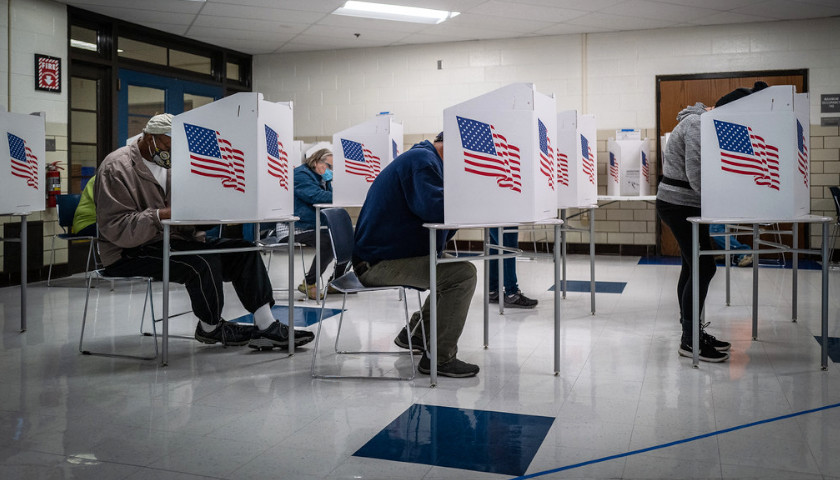by Natalia Mittelstadt
Maricopa County, Ariz., uses in-person voter turnout data from prior elections for planning where to place vote centers for future elections, but the county also categorizes the data by political party, raising election integrity concerns that voters of different parties could possibly have different Election Day experiences based on their location.
On Monday, a picture of a Republican in-person Election Day and early voting turnout heat map at Maricopa County Tabulation and Election Center (MCTEC) was tweeted by Kari Lake’s campaign Twitter account, linking to an UncoverDC article.
Citing the Republican voter turnout heat map, the tweet posed the question: “Why would you need one for Republican voters but not Democrats?”
Later Monday, Maricopa County released a picture of the Republican voter turnout map beside the Democratic map and an all-voter turnout map. Lake’s campaign account then deleted their original tweet and retweeted another account’s post of the full picture, captioning it: “Consider our concerns rested for now on this issue.” (UncoverDC also updated their article with the new information.)
Maricopa County was kind enough to leak former-Soros employee & current Democrat activist @jeremyduda a full picture of both maps.
Consider our concerns rested for now on this issue. https://t.co/sNL6VCtNOK
— Kari Lake War Room (@KariLakeWarRoom) December 13, 2022
When reached for comment about the heat maps on Monday, a spokesperson for the Maricopa County Elections Department told Just the News:
“Maricopa County elections uses heat maps from past turnout to make data-driven decisions on the best places to have voting locations in future elections.
“The Maricopa County Recorder’s Office has a Geographic Information System (GIS) team that makes all of the maps in-house. We use the turnout data by party for elections such as the Presidential Preference Election, which is a party-only election. We use the all-voter maps for future planning for Primary and General elections.
“In the MCTEC hallway, we have a Democratic In-Person Voter Turnout Map, a Republican In-Person Voter Turnout Map, and an All Voter In-Person Turnout Map. We also have maps on early voting in-person turnout by day, which help us ensure future early voting sites are also located where voters live.”
The spokesperson provided two photos, one of the three maps side-by-side on the hallway wall, and another photo of “early voting in-person turnout by day.”
On Tuesday, the Maricopa County Recorder’s Office initially gave an explanation of the heat maps that conflicted with the Election Department’s.
“Our Geographical Information Systems team prepares many of the different maps that line the hallways of our tabulation center,” the spokesperson said in a statement. “Some of these graphics include the various locations of our uniformed and overseas voters, early/in-person voting trends, and the demarcation of legislative districts throughout Maricopa County.
“These hallway graphics do not serve a functional purpose, other than serving as a neat visual aid to voters who come to tour the facility. Please note that the Republican heat map is immediately adjacent to the Democratic heat map.”
Later, when the recorder’s office was asked a clarifying question about the maps not being used to plan for future elections, the spokesperson reiterated that the maps in the hallway don’t serve a functional purpose, but then repeated the Elections Department’s explanation of heat maps being used for determining vote center locations.
The 2022 midterms were the second national election cycle that Maricopa County has had vote centers with ballot-on-demand printers, rather than precincts. The precinct election model requires voters be assigned to specific polling locations to cast their ballots on Election Day. With vote centers that have ballot-on-demand printers, however, voters may choose to vote at any location in the county.
Just the News asked Pima County, which neighbors Maricopa and skews heavily Democratic, if they similarly use voter turnout data in preparing for elections.
“Historical voter turnout is useful for planning purposes,” the Pima County elections director told Just the News on Thursday, while noting that this was the first year the county had vote centers instead of precincts, so 2020 voter turnout data would not be useful.
“I will likely use 2022 data to determine turnout for the 2024 election cycle,” the director said, while at the same time explaining, “Political party turnout is not as important since we use ballot-on-demand printers in our vote centers.”
Election integrity watchdogs contacted by Just the News, meanwhile, questioned the rationale for using any heat maps sorting voters by party in the nonpartisan administration of elections.
“There is no reason for a heat map at all,” Election Integrity Network Executive Director Marshall Yates said Thursday, adding that election administration must be “nonpartisan” and “fair.” Since all voters are to be treated equally, he argued, Maricopa has no legitimate need for in-person voter turnout data sorted by party.
Phill Kline, director of the Amistad Project, told Just the News on Monday that there “should be no reason” for a “government office to be involved in voter behavior,” unless it’s to determine and prepare for turnout. But even for turnout preparation a voter’s party registration should be irrelevant, Kline said.
Mohave County Board of Supervisors Chair Ron Gould similarly told Just the News on Monday that voter turnout data for election preparation should include only the number of voters, not their political party.
According to a lawsuit filed by Lake challenging the administration of the 2022 election in Maricopa County, a poll found that 58.6% of Republican voters in the county “reported having issues while trying to cast a ballot on Election Day,” compared to 15.5% of Democrat voters,
The lawsuit also alleges that 59% of Maricopa County’s 223 vote centers suffered ballot printer and tabulator failures.
– – –
Natalia Mittelstadt graduated from Regent University with Bachelor of Arts degrees in Communication Studies and Government.
Photo “Election Day” by Phil Roeder. CC BY 2.0.








